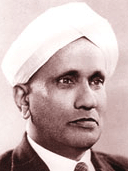| Chandrasekhara Venkata Raman (1888 - 1970) |
C.V. Raman born at Trichinnapalli in Southern India. His father was a lecturer in mathematics and physics. He entered Presidency College, Madras, in 1902, and in 1907 he gained his M.A. degree, obtaining the highest distinctions.
His earliest researches in optics and acoustics - the two fields of investigation to which he has dedicated his entire career - were carried out while he was a student. Since at that time a scientific career did not appear to present the best possibilities. Raman joined the Indian Finance Department in 1907; though the duties of his office took most of his time, Raman found opportunities for carrying on experimental research in the laboratory of the Indian Association for the Cultivation of Science at Calcutta.
|
 |
He is the man who placed India on World Map by discovering the Raman Effect. The Raman Effect is being used as an extremely refine tool to study the solid, liquid and gasses in modern laboratories across the world. In 1917 he was offered the newly endowed Palit Chair of Physics at Calcutta University. After 15 years at Calcutta he became Professor at the Indian Institute of Science at Bangalore and since 1948 he is Director of the Raman Institute of Research at Bangalore, established and endowed by him.
In 1922 he published his work on the "Molecular Diffraction of Light", the first of a series of investigations with his collaborators which ultimately led to his discovery, of the radiation effect which bears his name. He was given a Noble Prize in Physics. His birthday is celebrated as a National Science day all over India. The fillip that Raman gave to India's recovery and upsurge of science is immeasurable.
|
|
| |
| Category filed under: Scientist |
|
|